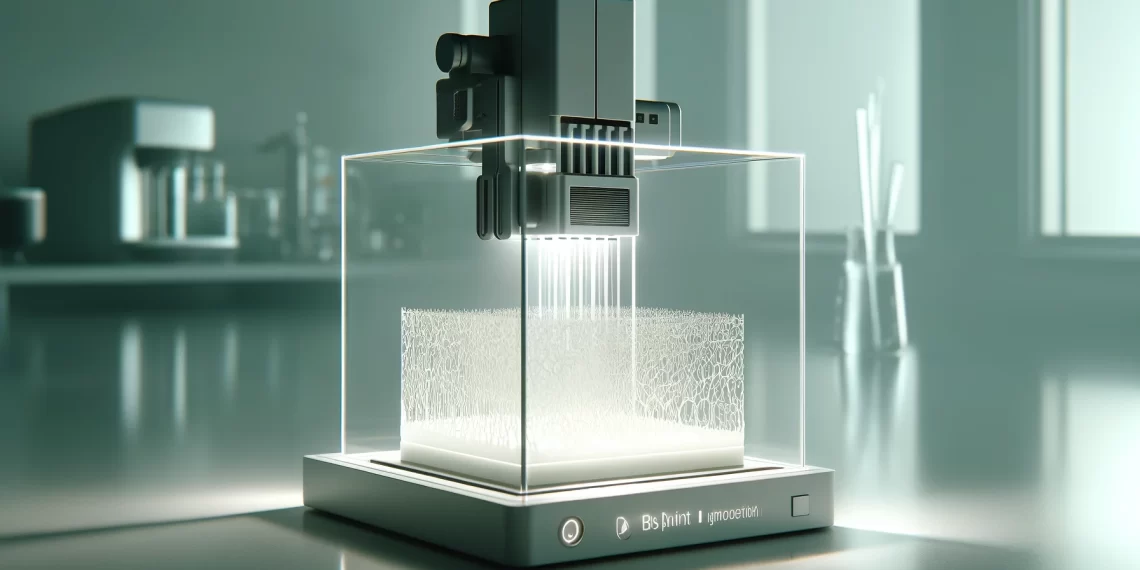Dr. Hao Liu at ETH Zurich has developed a pioneering laser bioprinter, introducing a new era in tissue engineering that could impact regenerative medicine, ethical food production, and even the future of warfare. By creating microscopic scaffolds mimicking natural tissue structures, this technology promises faster recovery from injuries and enhanced research capabilities, with implications for both civilian and military applications.
Liu’s technique utilizes a laser to form delicate microfilaments within a specially designed gelatin, creating an ideal foundation for cell growth. These bioprinted scaffolds replicate the precise alignment of cells in muscle, nerve, and connective tissues, making them suitable for repairing damaged tissues and modeling complex biological systems. With potential uses in battlefield medicine, this innovation could drastically reduce recovery times for wounded soldiers, enhancing combat readiness and resilience.
The bioprinting process leverages a unique phenomenon called filamented light (FLight), allowing precise cell alignment within hydrogel-based scaffolds. By controlling laser exposure, Liu’s team solidifies the gelatin into hydrogel where necessary, forming fine, thread-like structures. “Where we expose it with a laser, it solidifies into hydrogel. Wherever the laser can’t reach, the gelatine remains liquid,” explained Liu. With cell sizes ranging from 2 to 20 micrometers, these microfilaments can grow organized cell structures resembling muscle, tendon, and even nerve tissues.
This breakthrough holds particular relevance for military medicine, as the bioprinter could be used in field hospitals or other tactical environments to produce human tissue on demand. The rapid production of tissue could address the urgent need for wound care in combat, enabling soldiers to recover more quickly and potentially return to duty with fewer long-term health impacts. By expediting tissue repair, this technology could allow medics to stabilize injuries in real time, improving survivability rates and enhancing military readiness in high-stakes situations.
Additionally, the bioprinter’s capacity to produce nerve tissue models introduces a promising avenue for treating battlefield injuries involving nerve damage, a common injury in combat scenarios. This tissue replication technology may soon allow for precise modeling of injuries, enabling scientists and military doctors to tailor treatments directly to the wounds sustained by soldiers. ETH Zurich’s patented bioprinting technology, when applied to regenerative medicine, could prove vital for addressing injuries unique to combat, providing much-needed solutions for military personnel.
The implications of this bioprinter extend beyond just medical care. As the military explores lab-grown food options to support troops in remote areas, the laser technology could provide a scalable method for producing muscle-like structures, essential for lab-grown meat. This would allow the military to generate sustainable food sources in combat zones or supply chains where traditional provisions are limited, enhancing logistical independence and resilience.
Dr. Liu’s research has also attracted attention for its potential in enhancing medical research through precise disease modeling. In military contexts, this technology could enable drug screening specific to environments soldiers encounter, such as extreme climates or hazardous regions. “Our aim is to create human tissue models for high-throughput drug screening and other applications,” Liu said, indicating the versatility of the bioprinter in various fields. Aided by accurate tissue models, scientists could develop treatments that address both immediate and long-term impacts of chemical or biological exposure, ensuring the health of soldiers and civilians alike.
With the advent of this advanced tissue-engineering technology, the U.S. military could potentially adopt the ETH Zurich bioprinter for specialized applications in field hospitals, medical research, and logistical supply chains. As modern warfare grows increasingly complex, innovations like Liu’s bioprinter could equip the armed forces with adaptable resources for both healthcare and sustenance. While Liu’s primary goal is to address medical challenges, the implications for military applications are profound, underscoring a commitment to strengthening not only medical science but also strategic defense.








